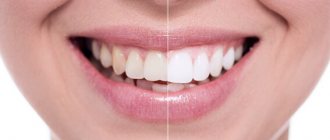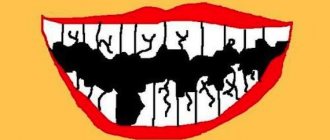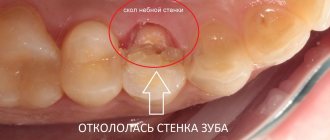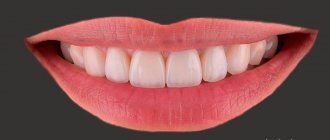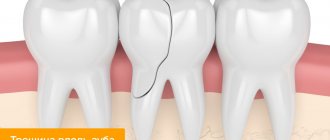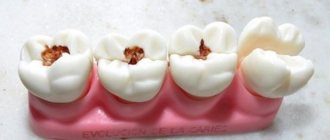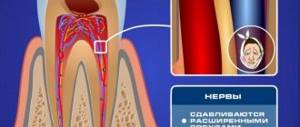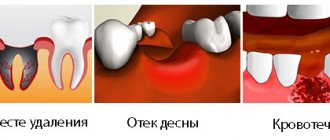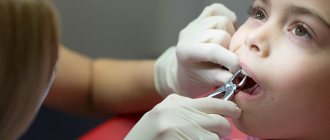Having installed braces in installments , at full price or on a promotional basis, the patient receives recommendations from the attending physician on how to care for them. Orthodontic treatment is accompanied by the need to especially carefully observe the rules of oral hygiene, as well as to stop eating a number of foods. A patient who does not follow these rules may experience braces coming off.
Metal, ceramic and sapphire braces are attached to the teeth using a special glue. Alignment of teeth and reduction of gaps between them is carried out using an orthodontic metal arch passing through braces and secured to the molars. Due to the tension arising in the system, the teeth gradually change their position, lining up in an even row.
| Metal braces When you decide to pay attention to your smile and make it perfect, you will be faced with the question: what method of bite correction should you use? Orthodontics has come a long way in recent years, and many new techniques and devices have appeared. But high-quality metal braces remain one of the most popular types of teeth straightening today. Specialists at the Moscow Smile Studio clinic often recommend metal braces to their patients, and there are explanations for this. | 99 900 ₽ Interest-free installments for 12 months! |
The stability of a tense brace system is highly dependent on increased pressure or sudden physical impact on its elements. If the glue used cannot withstand the additional load, the fixation of one, or less often several elements, may be broken.
Why do they put braces on teeth?
Installation of braces is a common method of orthodontic treatment. These structures help correct malocclusion, straighten teeth and help make your smile beautiful.
In this article
- Why do they put braces on teeth?
- How is a braces system installed?
- The bracket came off: what is the reason?
- What to do if the bracket comes off?
- The bracket has come off - what to do? Option 1
- Option 2
- Is it possible to reinstall a loose bracket?
- How does gluing happen?
- How long can you walk without braces?
- What to do if the last bracket comes off?
- Prevention of braces coming off
- Conclusion
Braces are small plates attached directly to the surface of the tooth, which are combined into a common system with a metal arch with shape memory. The orthodontist first calculates where the bracket should be placed on the tooth so that the displacement occurs in the right direction. And when the arch tries to return to its original shape, it puts pressure on the braces, and they, in turn, affect the teeth.
Content:
- Preparatory activities
- Options for installing braces 2.1. Direct method 2.1.1. How it goes 2.1.2. Advantages and disadvantages 2.2. Indirect method 2.2.1. Advantages and disadvantages
What result will be obtained after fixing braces depends on many factors. But the most important thing is that the installation of the leveling structure is done correctly. If you fix the device incorrectly, the teeth will close at the wrong angle. Then there will be no need to talk about any correction of the bite, no matter how long the patient walks with an “iron smile.”
How is a braces system installed?
First, based on X-rays and digital photographs, the orthodontist makes the necessary calculations and draws up a personal orthodontic treatment plan. Then, together with the patient, he selects a suitable brace system (metal, sapphire or plastic, external or internal). The next stage is preparation for the installation of braces, in particular the sanitation of the oral cavity. At this stage, it is necessary to cure caries and other diseases, replace old fillings with new ones, and, if necessary, separate or remove teeth that may interfere with the correct displacement of other units in the dentition. After sanitation, you can proceed directly to fixation. How is the bracket attached? There are two main installation methods - direct and indirect fixation. In the first case, plaque is removed from the enamel surface, etched, an adhesive base is prepared, the bracket is fixed using a composite material, and polymerization is carried out with light. With indirect fixation, braces are installed from a mouthguard previously made using photographs of the patient’s jaw. After preparing the enamel, the aligner with braces is fixed to the teeth and polymerized with light. The indirect fixation method is considered more accurate and takes half as much time as direct installation on each tooth separately.
After gluing the braces to the surface of each tooth, they are connected to each other using a metal arch. Attaching the arch to the braces can be done using the ligature method - using clasps and elastic bands. Or without ligation, when the arch is fixed with special clips.
The bracket came off: what is the reason?
Sometimes a patient who wears an orthodontic device encounters such a problem that the bracket falls off. Let's look at the main reasons that can lead to such a situation.
- Inaccurate brushing of teeth.
The presence of braces in the mouth greatly complicates the process of oral hygiene. For careful and thorough dental care, a regular brush is not suitable, but several devices are needed at once - a brush with V-shaped bristles, a brush for cleaning teeth under the arch and an irrigator. If you use these devices carelessly or try to clean the braces with a regular brush, pressing hard on it, the plates may fall off.
- Poor hygiene.
The brace can come off not only due to too much activity, but also due to poor oral hygiene. In this case, cariogenic bacteria accumulate around the plate, plaque forms, which leads to the destruction of the enamel and the bracket coming off.
- Eating solid foods.
After installing the braces system, the dentist must provide nutritional recommendations. In particular, in order not to damage the orthodontic structure, it is recommended to exclude nuts, crackers and other hard foods from the diet. Dentists also do not recommend overusing toffees and other products that stick to teeth. If the patient neglects these recommendations, the situation when another brace falls off will be repeated regularly.
- Features of fixation.
Braces are attached to the surface of the tooth with a special glue. It has such a composition that after the end of orthodontic treatment the structure can be removed without damaging the tooth enamel. Thus, this adhesive composition, although quite durable, is not able to withstand every load. As part of the design, each bracket is pressed to one degree or another by a power arc, which thus “pulls” the teeth along with it. If a person has crowded teeth or a severe malocclusion, the pressure on different braces will be uneven. Due to this load distribution, some plates may come off. Most often this happens in the first days and weeks after installing the braces system.
- Unprofessional approach.
Some dentists use filling material instead of a special adhesive to glue braces. This method of attachment is less reliable, and braces fall off more often. There are also doctors who, when attaching plates, do not take into account the individual anatomical features of the patient, and the bracket can come off simply when the teeth are closed.
Thus, the reasons for the unsticking of the braces can be the actions of both the patient himself and the orthodontist. In both cases, the main question is what to do if the bracket falls off?
Dangerous situation
When the bracket comes off, there is a risk that the patient will swallow the element. The part does not have sharp edges and does not pose a danger to the digestive system, but it can cause discomfort. In such a situation, no special measures need to be taken; the element will come out naturally.
The main danger is that when the braces system breaks down, the pressure on the dentition changes. If the patient does not seek qualified help for a long time, the teeth may return to their original position and the treatment process will drag on indefinitely.
Also, peeling off one or more elements can lead to uneven pressure distribution. In such a situation, an incorrect bite may form and the result of treatment will be unsatisfactory.
If your braces have fallen off, do not put off visiting the orthodontist. If it is not possible to visit a doctor in the near future, the patient should independently remove the structure or fix the damaged element.
What to do if the bracket comes off?
The most correct thing to do in such a situation is to immediately call the orthodontist and make an appointment, and not try to glue the braces into their original place yourself. When the plate is not attached to the tooth, it does not perform its main function - correcting the bite. But the worst thing is that the overall effectiveness of orthodontic treatment is impaired. As other teeth gradually shift, one remains in place. This violates the treatment plan precisely calculated by the dentist and can ruin the entire process of bite correction or increase the period of wearing the braces.
Unfortunately, it is not always possible to quickly see a doctor: sometimes a specialist has an appointment several days in advance or you are in another city. Is it worth removing braces at home or what is the right thing to do in this case? Your actions will depend on whether the bracket is held in the arch or not.
Is it possible to walk with a broken brace?
Braces are a single and complex mechanism. When one component comes loose, the functionality of the entire bracket is impaired. Therefore, it is important to visit an orthodontist as soon as possible if damage occurs.
Important!
If you continue to walk around with the brace unstuck, even on one tooth, then all the efforts previously spent on correcting the bite and uneven teeth will be in vain. A broken structure is deprived of the necessary strength and directional pressure, becoming useless or even causing damage to the jaw.
The bracket has come off - what to do? Option 1
If it comes off, but is held in a metal arc, proceed as follows. Pull the bracket out of the archwire. To do this, on non-ligature models it is enough to unfasten the clasp; on ligature models, you need to remove the elastic bands (these are ligatures). This can be done using tweezers, a toothpick or nail scissors. The goal is for the rubber band to come off the bracket. If you can’t remove it carefully, you can cut it, and the orthodontist will then easily replace the damaged ligature with a new one. Be sure to keep the braces and give them to the doctor when you see him.
Option 2
Do not try to remove a loose bracket if it is tightly held in a metal arch. In this case, the best option is to do nothing until you see a doctor. If you are afraid of losing the plate while eating or brushing your teeth, you can temporarily secure it with special orthodontic wax. It’s definitely not worth trying to forcibly tear the bracket away from the structure, because you can damage the entire device. In this case, it will need to be completely replaced, which will cost a lot of money and time.
Is it worth fixing the bracket lock yourself?
You still shouldn’t put off a visit to your orthodontist, otherwise after a few days the archwire risks tearing off again and injuring the mucous membrane with protruding zones of broken braces. A priori, a full-fledged repair cannot be replaced by this method, but due to improper distribution of load and pressure, the teeth will begin to bend again , and the achieved result from the treatment will come to naught.
With such professional equipment that is in the mouth, you need to be especially careful. Many doctors advise immediately after installing braces to carefully study their location and specifics in front of a mirror in order to remember how they were originally located.
If the design allows you to remove a loose bracket without the intervention of an orthodontist, such manipulations should be carried out with extreme caution and without haste. It is sudden movements that most often disrupt the fixation of the rest of the structure, and the main thing here is not to aggravate the situation even further.
Attention! Due to the limited access to sevens and eights, retrieving loose elements near the back teeth can be truly challenging.
During dental treatment, it is worth constantly monitoring all the changes that occur to the teeth and carefully ensuring that the system remains complete until the end of its service life. And if any breakdowns are detected (including the considered falling off of the plates), take appropriate measures immediately.
Is it possible to reinstall a loose bracket?
Braces are not cheap. Therefore, when they come off, patients often ask doctors not to install a new plate, but to fix the one that has fallen off. The dentist can accommodate you if the braces are not damaged. But according to the standards of orthodontic treatment, this is not recommended. In particular, because such braces have already damaged the adhesive coating, which enhances adhesion to the glue, and they can fall off again.
How does gluing happen?
As soon as possible, you should go to the dentist to install a new brace. Usually, this requires disassembling the structure, removing arches and ligatures, cleaning, drying the tooth, and repeating the fixation procedures from the very beginning. If only one bracket has fallen off, then re-gluing it will take about 10 minutes. Some dental clinics offer patients 3-4 discounted procedures per year. If braces come off more often, in most cases this is due to non-compliance with the doctor’s recommendations, and you will have to pay for more frequent re-adhesions.
Some patients, in order to save money, try to glue the plate themselves. This cannot be done for two reasons.
- You do not have a special adhesive composition that is suitable for braces and is safe for teeth.
- It is necessary to glue the bracket in the correct position; this is the only way the bite will be corrected. Only an orthodontist can cope with such a task.
What to do if the last bracket comes off?
Any brace can come off, but most often patients complain that the bracket on the last tooth has come off. What is the reason? The distant teeth are chewing teeth, which is why they experience increased stress when eating. Therefore, it is easiest to rip off a bracket from a posterior chewing tooth. The procedure for gluing brackets on the outer teeth is no different from that described above. The only difference is that it is easier for the latter to jump off the arch, so it is advisable to immediately remove them and save them until a visit to the dentist.
Problems after removing the system
Braces are removed after the teeth have reached the desired position. After removal of the elements of the orthodontic structure, slight mobility of the elements of the jaw line may be observed, which is explained by a violation of the structure and elasticity of the tissues surrounding them.
Since the pressure no longer exists, the teeth can tend to return to their original position. To avoid this scenario, orthodontists recommend using retainers after removing braces.
Retainers are a device that helps keep teeth in their position after correction by creating resistance.
At this time, a ligament is formed and strengthened around the tooth, holding it in a given place.
The process of tissue growth is quite long and can reach 3-5 years, however, after its completion, the molars are firmly fixed and their mobility is completely eliminated.
In the form, look at what happens while wearing braces.
Prevention of braces coming off
In most cases, it is possible to prevent braces from coming off if you follow preventive measures, which include strictly following the doctor’s recommendations.
- Dieting.
In the first days after the installation of an orthodontic structure, it is advisable to eat only soft and liquid foods - cereals, smoothies, yoghurts, cottage cheese. It is at this time that the risk of peeling is highest, and following a diet will help prevent it. In the future, you can eat different foods, with the exception of hard, sticky, too small (they will get stuck in braces) and coloring.
- Control of bad habits.
The habit of chewing the tip of a pencil or biting your nails not only leads to chipped teeth, but can also lead to peeling.
- Take good care of your braces.
When cleaning, all movements with a brush or brush should be smooth and careful so as not to damage structural elements. If you use an irrigator, be sure to choose a model with an orthodontic attachment - it is specially designed for gentle cleaning of brace systems.
- Maintain good oral hygiene.
If you don't brush your teeth thoroughly enough near the braces, a carious process can begin, which not only leads to the plate coming off, but also requires mandatory treatment. If the doctor diagnoses caries, the system will have to be completely removed, the teeth treated, and then reinstalled. This can be avoided by regularly cleaning your teeth and mouth, following the hygiene recommendations given by your dentist.
Why do braces come off?
There are several reasons why the structure moves away from the tooth enamel:
- In the initial stages of treatment, this is due to crowding of organs and lack of space in the oral cavity. As the voltage increases, the structure peels off.
- If you move the toothbrush carelessly.
- Eating tough, hard and sticky foods.
- When you try to pull something out of a brace or from your teeth (for example, when food remains get stuck in structural elements).
- With a gradual change in the bite, the structure begins to contact the opposing units.
